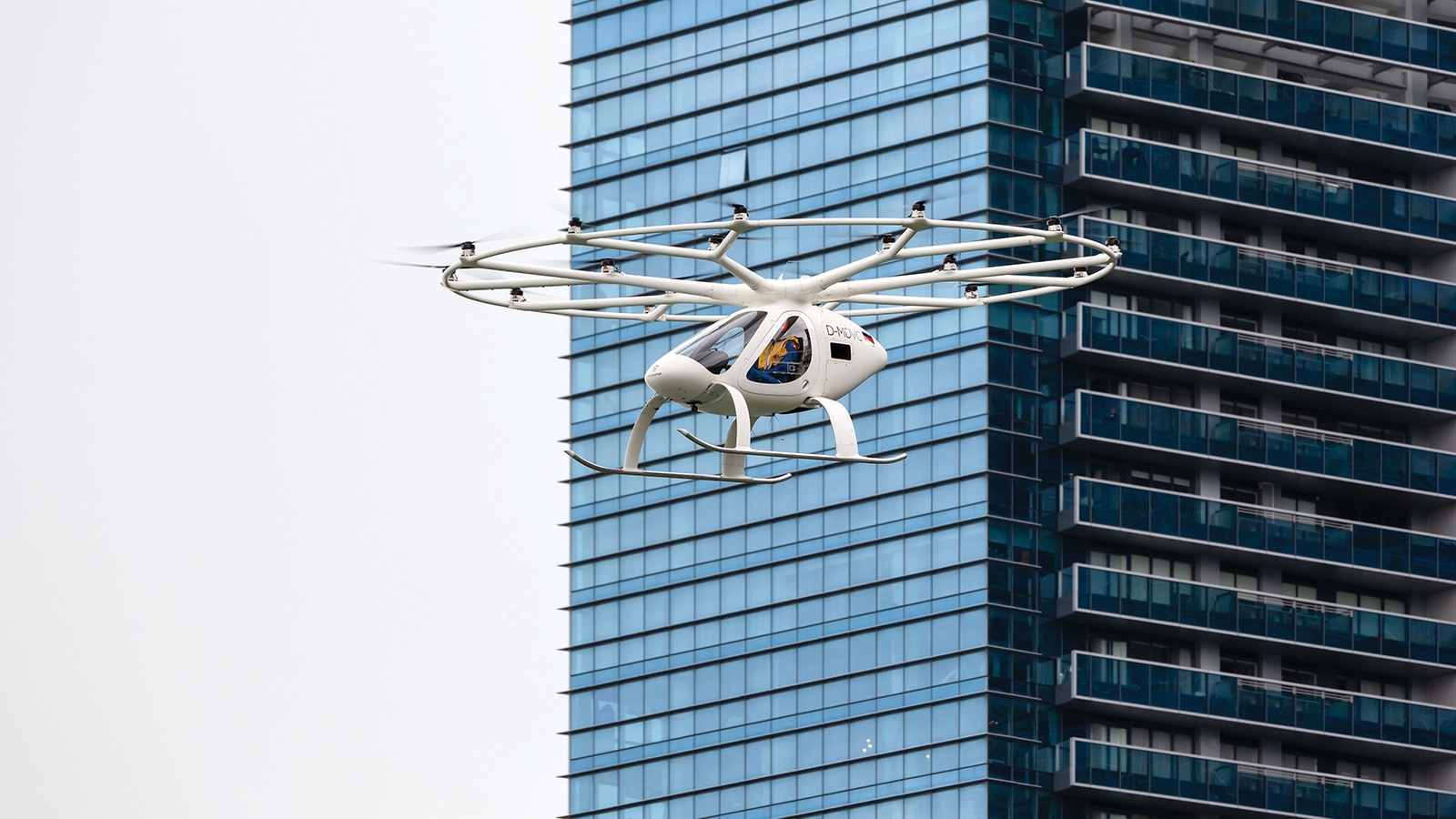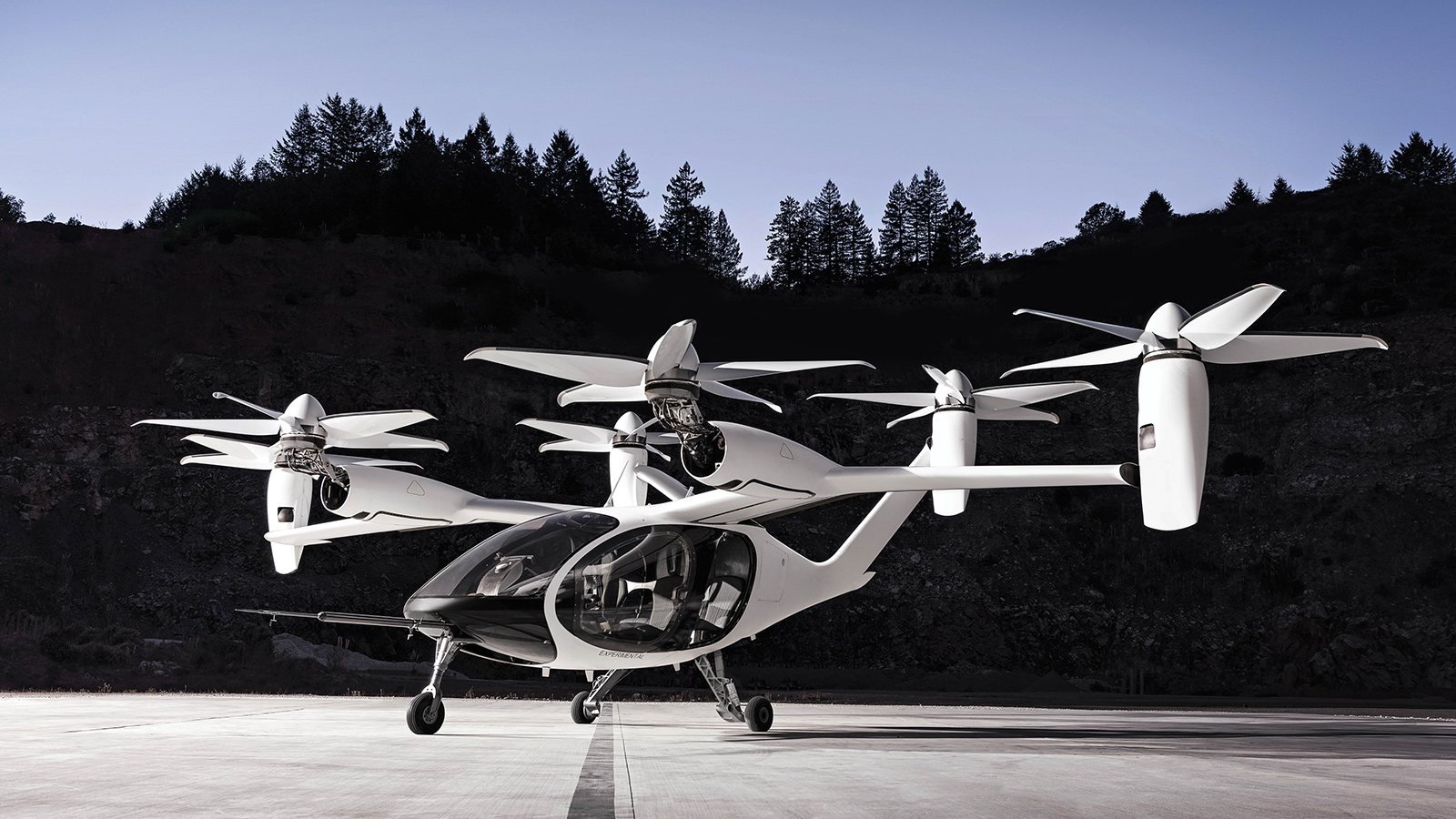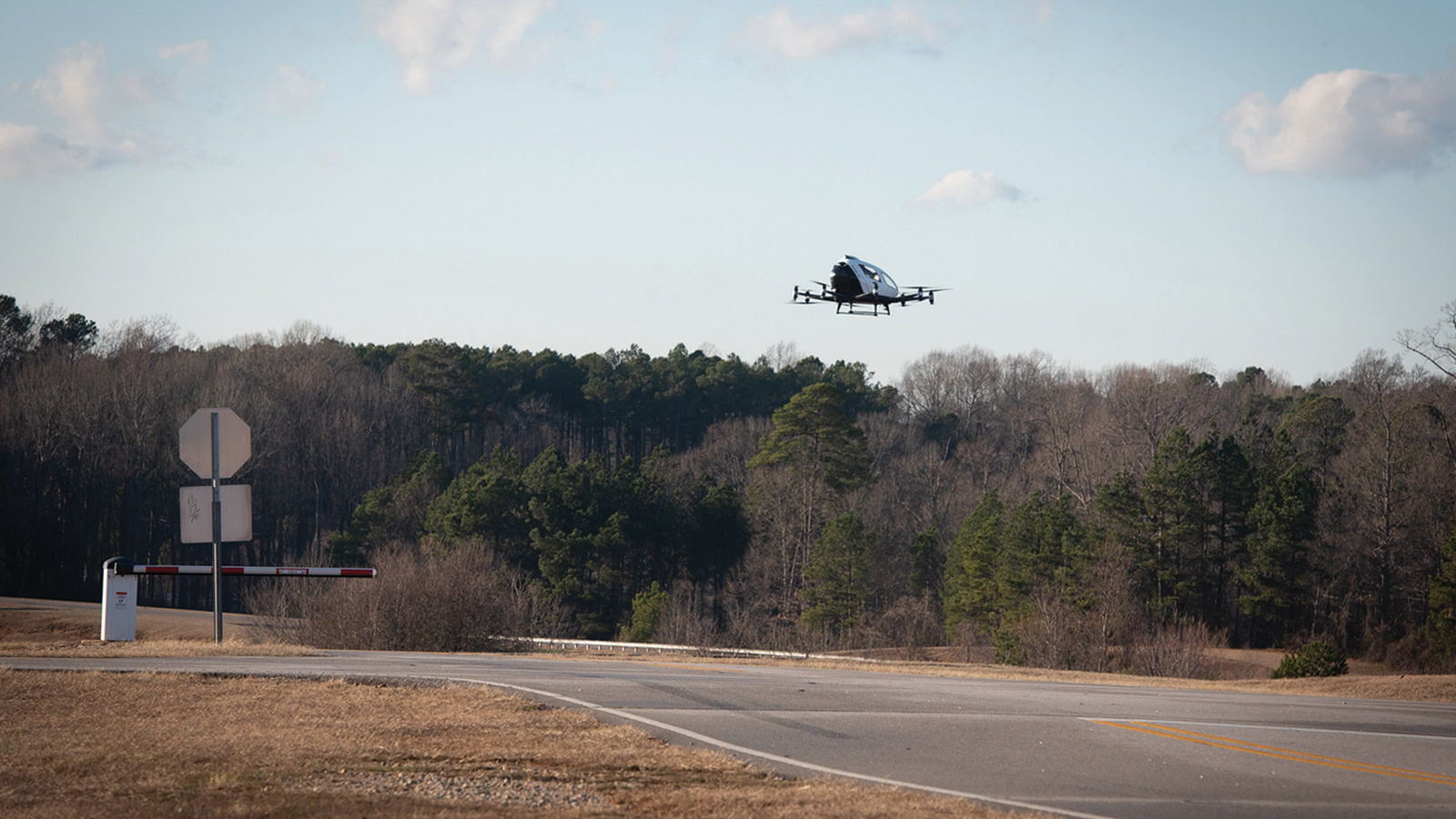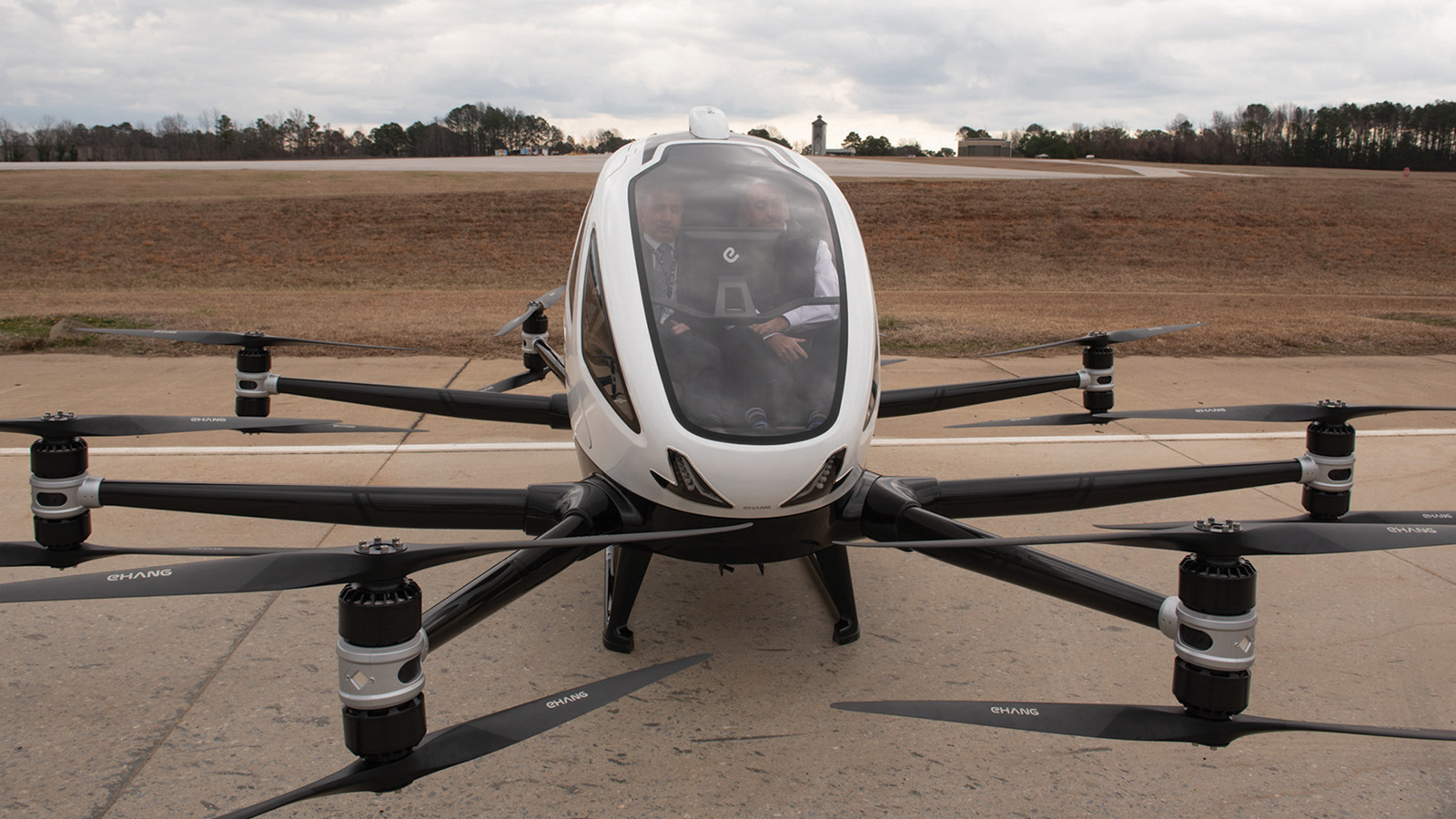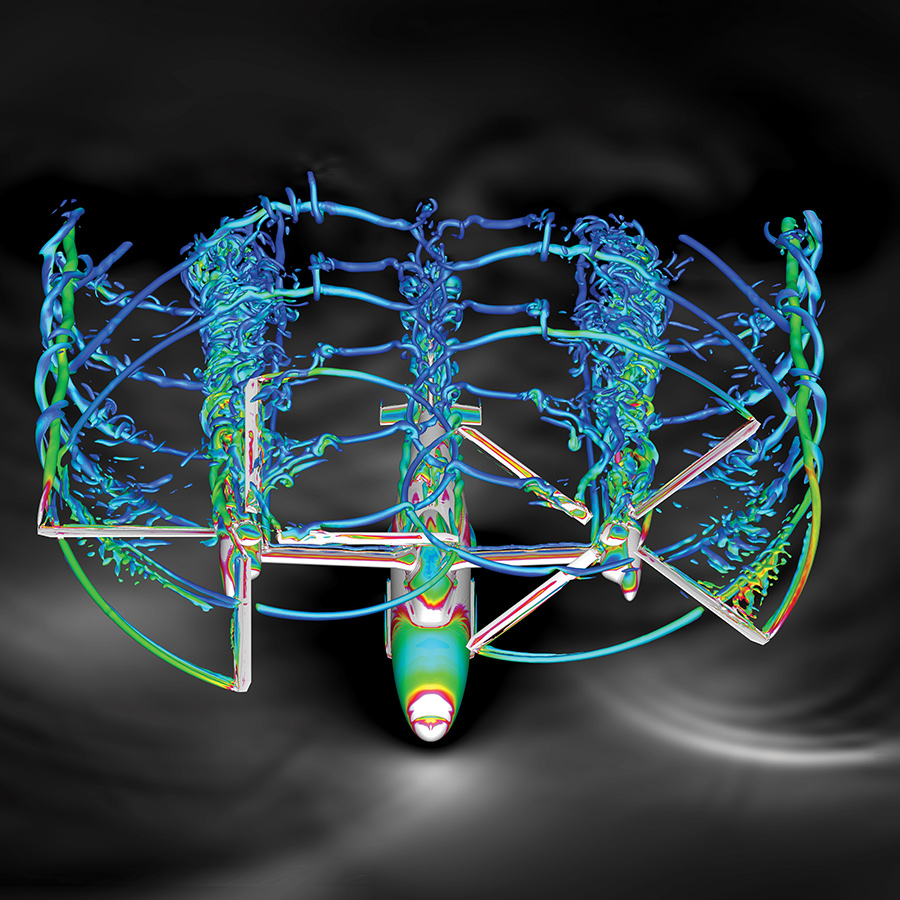Stay Up to Date
Submit your email address to receive the latest industry and Aerospace America news.
Dozens of companies are designing and in some cases test-flying urban air mobility aircraft, also known as air taxis. No one can say for sure how U.S. residents will react to such aircraft whooshing overhead or easing onto the vertiports that might one day sprout up on the fringes of their neighborhoods. Jan Tegler tells us about a NASA-led campaign to find answers.
Basil Yap is one of the few people in the U.S. who has heard the sound made by a prototype urban air mobility vehicle, or air taxi. The unmanned air system program manager for the North Carolina Department of Transportation was on hand in early January for a demonstration flight of the EHang 216, a Chinese-built remotely piloted aircraft with two passenger seats, although on this day it was flown with no one aboard. Powered by 16 electric motors and rotors, the craft made a five-minute flight over a grassy, tree-lined area in front of North Carolina Gov. Roy Cooper, state legislators and staff from the Department of Transportation.
Yap says the multirotor vehicle was “not as loud as I expected” with “a hum at a much lower frequency” than small consumer drones, while noting that a consistent wind might have diminished the noise from the aircraft 150 meters away. During a preliminary flight earlier in the day, Yap stood 60 meters from the EHang 216 as it passed. He said the sound was “bearable, maybe half as loud” as a helicopter.
Noise is one of the top two challenges facing the emerging urban air mobility, or UAM, industry. Proponents including Uber Elevate, the rideshare behemoth’s initiative to give customers airborne options, envision a future of thousands of air taxis shuttling commuters around urban and suburban locations.
Before the UAM business can take off, regulators will have to define and create a host of standards describing how these craft should operate, including limits on noise.
NASA, FAA and university researchers are developing software tools to model and predict UAM noise, the goal being to aid manufacturers in designing quieter vehicles. Developers will begin assessing the accuracy of those tools during NASA’s Advanced Air Mobility National Campaign, formerly the UAM Grand Challenge, a series of four test events between now and 2027. NASA will kick off the campaign in November, readying testing procedures for initial flight trials in early 2021 with Joby Aviation of Santa Cruz, California. The company will fly its prototype air taxi at the U.S. Army’s Fort Hunter Liggett near King City, California, in scenarios designed to help FAA “better understand how UAM vehicles fly,” says Starr Ginn who leads the campaign. The four test events will build toward tests in an urban environment, Ginn adds.
Benchmarking the noise made by individual and multiple vehicles will be one of the many focus areas of the campaign’s test events. Ultimately, the data gathered will help FAA set noise certification standards for each UAM craft. But how long it might take to certify each type of UAM vehicle for noise is unknown at this point, according to FAA. That could impact Uber Elevate’s plans, given that Joby Aviation, Uber’s first aviation partner, has a “committed timetable” to begin flying customers in 2023, according to a joint Joby-Uber December press release announcing the agreement.
Further, for noise standards to be meaningful, regulators may have to go beyond setting an objective certification decibel level for noise, says Susan Gorton of NASA’s Langley Research Center, who leads the agency’s Revolutionary Vertical Lift Technology project.
“Where is the threshold for annoying noise?” Gorton says. “There’s a difference between the noise level that is a certification standard and what is acceptable to the public for UAMs operating near and around them in a very high-tempo operation. We’re trying to characterize human response, what the metrics for annoyance might be and how they could be taken into account in vehicle design.”
According to FAA, an annoyance metric is not in its plans for UAM noise certification. Standards for noise certification are based on the effective perceived noise level, or EPNL, the agency says. This is the same metric the FAA applies to traditional airplanes and helicopters. Described by the International Civil Aviation Organization as “a single number evaluator of the subjective effects of aircraft noise on human beings,” EPNL is a measure of the aircraft noise people hear from the ground.
Of course, in the future, tens, hundreds or even thousands of UAM vehicles could be flying in a locale. That scenario could give someone on the ground a sense that noise is coming from all directions, even if the decibel levels of individual aircraft might meet a standard. FAA told me that its noise certification “does not account for the number of operations of those vehicles.”
That puts further emphasis on the question of public acceptance of UAM noise or “community noise,” as FAA refers to it. However, FAA explains that for certification a UAM vehicle “does not need to be tested in multiple places.” The agency says that its research program for UAM and community noise is still evolving, and “FAA has not determined the extent of the testing/measurement needed.”
What do they sound like?
FAA uses EPNL, measured in decibels, to set noise certification standards. This is done by calculating the sound an aircraft makes over the course of 10-second “pass-by” events. Pass-by events are recorded in three flight phases — takeoff, flyover and approach — by ground-based noise measuring stations below the vehicle’s flight path in open terrain. Integrating the instantaneous noise levels captured by microphones along the flight path over the period of the pass-by produces an EPNL.
Gorton says NASA can’t state what specific EPNL number a UAM vehicle should aim for yet and FAA tells me it currently “does not have a decibel level target in mind for UAM noise reduction.” But Carey Cannon, chief engineer of technology and innovation at Bell, says that he’s hearing that “UAMs need to be 15 decibels quieter” than helicopters.
According to Cannon, Bell’s Nexus 4EX prototype air taxi, an optionally piloted five-passenger vehicle with four electrically powered ducted fans has so far yielded “a 7-decibel noise reduction” compared with traditional helicopters at a simulated altitude of 400 feet in wind tunnel testing.
Eric Greenwood, an assistant professor of aerospace engineering at Penn State who specializes in helicopter acoustics research says, “You have to get a 10-decibel reduction for an aircraft to sound half as loud, at a perceived decibel level.”
Martin Peryea, chief technology officer for Jaunt Air Mobility, says the New Jersey company’s electric gyrodyne, the term for an aircraft that combines rotor lift with the forward propulsion of a propeller or propellers, will achieve a reduction of 20 decibels in noise compared to helicopters in a similar gross weight class. Jaunt’s gyrodyne design has a single large main rotor for vertical takeoff and landing and four wing-mounted propellers for forward flight.
“I’ll take these predictions to the bank because of the configuration of our aircraft,” he says. The Jaunt prototype aircraft, due to fly in 2023, will produce an approach noise level of “roughly 70 decibels” EPNL.
Joby Aviation’s all-electric air taxi powered by six tilt rotors, which has made some piloted test flights, produces less than 70 decibels of noise at 500 feet altitude, the company says.
A generic vehicle
UAM vehicles, whether concepts or flying prototypes, are incredibly diverse, including wingless multirotor, ducted fan and combination rotor/propeller designs as well as tilt-rotors, tilting jets and flying cars. Propulsion includes hybrid-electric, all-electric and hydrogen-powered options.
Gorton says that assessing the noise the wide variety of designs may make is challenging, but she explains that NASA plans to get around that problem in part by testing the noise made by a range of components not tied to one vehicle configuration.
“We can do a lot of our validation data and testing with components that are generic — a generic wing, with several props, for example. My project just completed a test in a wind tunnel at NASA Ames [in Silicon Valley] last fall on what we call the multirotor test bed. It’s a generic, fixed prop-rotor configuration.”
Charles Tinney, a research scientist at the University of Texas at Austin’s Applied Research Laboratories who studies the noise signatures of drones, says that testing generic components should provide useful noise data for regulators and UAM designers but cautions that the variety of approaches to design makes it hard to account for the noise every configuration may make. Also, UAM manufacturers are protective about the competitive details of their technology, which doesn’t help.
“It’s hard to even come up with a generic platform because almost none of the private sector are willing to share their information with us,” Tinney notes.
Gorton says NASA is used to working with proprietary concepts. For example, NASA has made preliminary measurements of the noise from SureFly, the electrically powered, eight-rotor UAM prototype built by Moog Inc. of Elma, New York.
“Intellectual property isn’t an issue,” she says. “With resources we have and with partners, I think we’ll be able to work with the FAA to get the basis for certification that they need.”
Broadband noise
Gorton says NASA also understands the need to predict the noise that many UAM vehicles in flight simultaneously will make. Multiple vehicles approaching or departing vertiports — sites where commuters would board or exit an air taxi — are a special concern. “We’re looking at a tool to predict the noise from multiple operations over a certain trajectory in a certain area, but we’re not there yet.”
Broadband noise, the term for a sound that a listener can’t pin to a specific source, will be a focus of NASA’s research, Gorton says. Produced by a single vehicle or by multiple vehicles, Gorton likens broadband noise to the noise you hear when you lean your head against the cabin of an airliner in flight. “It’s the kind of noise that raises the noise floor, but it’s not distinguished by tone. Generally, you could describe it as a background noise level. You can’t pick it out, but it’s noisy. That’s the kind of noise we’ll have to look at for these vehicles.”
Measuring broadband noise will be part of NASA’s Advanced Air Mobility National Campaign, Gorton says. But for now, no one can say what kind of broadband noise tens or hundreds of UAM vehicles operating in proximity may generate.
Bell’s Cannon points out that noise predictions also should take into account the noise made by vehicles of various configurations. “At a vertiport you may have four Nexus 4EX vehicles, two of Joby’s aircraft and three of something else,” Cannon says. “What kind of noise will they make together? I don’t think regulation can happen until vehicles are being built and you can make a variety of measurements.”
Industry prognostications vs. noise certification
While FAA cannot say when a UAM vehicle will be certified for noise, the agency did tell me that no UAM manufacturer has as yet submitted a certification basis for noise, the precursor to going through the agency’s noise certification trials.
Cannon opines that the “basis for noise certification, not certification itself, is three to four years away.”
That would put Uber’s timeline for commercial air taxi operations in question.
Noise certification standards and the test methods described above are covered under Part 36 of FAA regulations. Part 36 standards apply to jet-propelled aircraft, large and small propeller-driven aircraft, helicopters and tilt-rotors.
The agency says it thinks Part 36 will be suitable for UAM vehicles as well. “Ideally, any new UAM could be certificated under one of these existing categories.” If the variance in UAM design proves too broad to be covered under existing regulations, FAA says it can write new standards. “USC 44715 (a section of federal code controlling aircraft noise and sonic boom) provides the opportunity for FAA to develop the necessary standards for any aircraft type, including UAM.”
Theoretically then, noise certification could get underway now. But if new standards have to be written, FAA cannot say how long that might take.
Gorton says she doesn’t expect NASA’s aircraft noise prediction software — the tools that will generate data for FAA — to be validated until 2023.
“We need to know how noise is generated at the vehicle and how it propagates to the ground through the atmosphere,” she explains. “What kind of environment are you in? Do you have reflections from buildings or absorption or scattering? What kind of weather conditions prevail? Those things all go into the prediction. I don’t think all of our terrain stuff is prime time yet.”
Recognizing that very few UAM vehicles are flying now, NASA must do what it can ahead of time to gather noise data and let manufacturers know how to make their vehicles as quiet as they can, says Gorton.
Tinney, the Austin researcher, cautions: “The last thing you want is for one of these new UAMs to come out and it has a horrible acoustic footprint and it automatically puts a bad taste in people’s mouths.”
Silence is impossible, and that’s “an unfortunate artifact of the physics of the problem,” he says. “There’s an annoyance perception issue that the UAM community is going to have to tackle as a whole.”
About Jan Tegler
Jan covers a variety of subjects, including defense, for publications internationally. He’s a frequent contributor to Defense Media Network/Faircount Media Group and is the author of the book “B-47 Stratojet: Boeing’s Brilliant Bomber,” as well as a general aviation pilot.
Related Posts
Stay Up to Date
Submit your email address to receive the latest industry and Aerospace America news.

